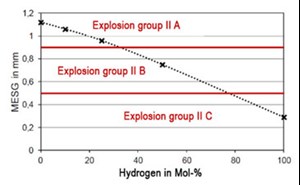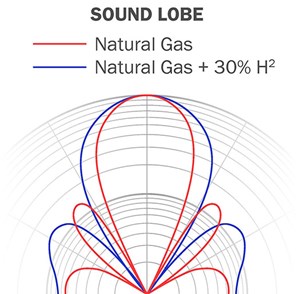Articles
Essentials for blending H2 and natural gas
Blending Natural Gas and Hydrogen
D. HARRIS, SICK, Friendswood, Texas
Hydrogen (H2) is steadily emerging as a vital element in global efforts toward decarbonization and electrification. The economic and socioeconomic climate is driving the H2 conversation. H2 is the lightest element and has no ingrained carbon; when H2 burns, water is released, which makes it, by definition, a carbon-free fuel. One of the ways to utilize this carbon-free fuel is to blend it with natural gas. Blending H2 and natural gas provides a more sustainable fuel. But what exactly happens when H2 and natural gas are blended?
To answer this question, how H2 is and can be used in clean energy must be discussed. Ultrasonic measurement is also explored here as a reliable way to monitor the amount of H2 in natural gas when blended.
The origin and availability of H2. Global H2 demand is about eight exajoules and is mostly utilized in refining applications—the projected demand to 2050 shows an increase in the H2 economy to 78 exajoules.
H2 is defined using a color spectrum. Although it is a colorless gas, it is defined by a rainbow of colors to differentiate between different types, despite no visible difference between them.
Primarily, the industry still uses gray H2. Gray H2 is produced by the steam methane reforming (SMR) of natural gas (TABLE 1). From this process, CO2 is produced and eventually released into the atmosphere. SMR is common globally in the refining sector, with heavy demands for H2. H2 generation with carbon sequestration will be used, as it is a commercially viable technology.
As the cost decreases and efficiencies increase, renewable H2 generation will also increase. Thus, the importance of the different colors of H2 will vary depending on demand and industry needs. It is important to note that H2 will not replace natural gas—only some 8%–12%, depending on the study, which is a small portion of the overall energy demand. Fossil fuels will continue to play a role, electrification will increase, and H2 will make up a portion of this energy future. However, long-term projections show that renewable H2 will be dominant through successive/disruptive innovation and significant cost reduction.
H2 timeline. FIG. 1 shows a timeline to illustrate H2 production and use as the technologies are available. Production will be localized. For example, in a power plant in Utah, U.S., H2 will be generated for local storage and use through the SMR process and some electrolysis. In Nebraska, U.S., a pyrolysis plant makes black carbon into H2. The near-term vision uses the existing infrastructure to move H2 and generate carbon-neutral fuels.
In a brief look at the industry’s future, after 2030, the industry will move to distributed generation using excess wind and solar. H2 will be blended and transported in the gas pipeline system, and there will be a greater focus on green energy electrolysis. Eventually, H2 pyrolysis technologies will go beyond commercial scale and reach 10–100 times the generating capacity. Natural gas resources and fossil fuel resources will be used to generate clean-burning H2.
Socioeconomic pressures are real, as many major energy producers and refiners are discussing beginning projects soon. Large cement manufacturers are working on carbon sequestration. However, there are still a lot of questions to answer, especially from the pipeline side. There has been significant work in Europe on putting H2 into the pipelines and grid and supplying municipalities with blended fuels. Unfortunately, the U.S. lags 5 yr–7 yr behind and has more questions than answers. The industry must work together to answer those questions.
H2 in energy. H2 is an energy carrier but can also be a storage medium. It can be produced from fossil fuels, biomass, solar, wind, nuclear and hydroelectric processes. Its uses are mainly in oil refineries, ammonia production, methanol and some steel applications. Additionally, the transportation industry and markets have increasingly used H2 fuel cells. This is because, by weight, H2 has three times more energy density than natural gas, meaning that it must be compressed at three times the pressure, as well. It can then be transported in a pipeline as a gas or liquid. Transporting liquid H2 requires temperatures of –252°C (–423°F), which is much colder than the requirements for LNG.
Why does H2 make sense as a fuel for the transportation industry? Fuel cells are a proven, efficient technology with no moving parts. They use a fuel's chemical energy to produce electricity cleanly and efficiently. Fuel cells work like batteries without running down or needing a recharge. Having such a great energy density makes H2 fuel cells an attractive source for heavy industrial or freight transportation. For example, one of the biggest names in diesel and diesel motors has a complete portfolio of fuel cells and electrolysis. One solution to create a much cleaner fuel for moving freight worldwide is to remove the diesel engine and use a H2 fuel cell.
The near term will mostly focus on addressing viewpoints and the electrification of vehicles, using H2 as the fuel rather than batteries. Other industry challenges include energy density, batteries and charging times. However, the ability to move freight long distances using a clean energy supply is very attractive for the future.
H2 in renewable energy. The project balance of commercial power producers is heavily weighted toward renewables. The present unsubsidized cost of generating electricity from wind and solar is on par with the cost of natural gas or fire generation. This is significant, meaning that power producers are voting with their budgets on how they will generate electricity. The challenge is that U.S. wind density is predominantly in the Midwest, while solar density is in the south and southwest of the country. Therefore, population centers are separated from these energy sources.
The energy must be able to move long distances to meet the demand, which is a challenge. Electrons can be transported in wires, but a lot of that energy is lost in transit. Therefore, putting H2 in a pipeline and storing or transporting it becomes a way to build a chemical battery. Excess wind and solar can be used when they are not needed to generate H2. Then, that H2 can be used to generate electricity where there is no sun or wind. Truly, a generation-to-consumption disparity exists where the excess electricity generation does not match the demand. However, H2 can be used to fill that gap.
Blending H2 in natural gas. H2 has unique characteristics that make it a preferred energy source. Beyond being a carbon-free fuel, H2 is eight times lighter than natural gas. It also has a speed of sound three times quicker than natural gas. The speed of sound in natural gas is around 1,394 ft/sec. If that is extrapolated, then H2’s speed of sound is 4,300 ft/sec. Additionally, natural gas will run from about 950 Btus–1,050 Btus/ft3 (British thermal units), while H2 is around 325 Btus/ft3. From a physical perspective, significant differences remain when comparing H2 to natural gas.
H2 characteristics:
- Eight times lighter than natural gas
- Three times higher speed of sound than natural gas
- Three times lower heating value than natural gas
- Lighter Btu/ft3.
One area that can cause challenges is the effect of blending H2 and explosion protection. The Federal Institute for Materials Research and Testing (BAM) investigated the impact of admixing H2 with natural gas on explosion behavior and requirements for the explosion group classifications. This report shows that the explosion pressure changes slightly to a H2 proportion of 25 vol%. Likewise, a 10-vol% admixture of H2 has no significant influence on the standard gap width for the gas group IIA (FIG. 2). The results lead to the conclusion that a 25-vol% admixture of H2 likely, does not inadmissibility reduce the standard gap width for the gas group IIA.
Today, a 10-vol% admixture of H2 is possible in Europe with the rules under consideration of specific applications or restrictions. The new regulation is intended to increase the admixture to 20 vol%. According to the current state of knowledge, this proportion is estimated to be technically feasible.
Acoustics basics:
- As H2 content increases, the speed of sound increases
- As the speed of sound increases, the sound lobe increases
- As the sound lobe increases, the line size limitation increases.
The sound lobe is the curved projection. As H2 content increases, the speed of sound increases; as the speed of sound increases, the sound lobe increases. In FIG. 3, the red line represents natural gas, and the blue line represents a sound lobe of natural gas blended with 30% H2. With increased admixtures of H2, there can be a line size impact with existing ultrasonic measurement equipment. Therefore, the H2 content must be included in the device’s design to create a specific solution. The amount of H2 incorporated into a specific facility cannot be ignored.
Ultrasonic meters and blended gas. The author’s company has participated in research on ultrasonic meters since the first installation in 2005. Since then, the company has been involved in the implementation of pure and mixed gases in the process industry. There have been numerous implementations where the meters have measured at 1%, 5% and up to 30% H2. These applications continue to be monitored and researched while ensuring measurement integrity for natural gas, blended natural gas with H2, and pure H2.
Ultrasonic meters are capable to meet the demands of a future network operation. The proof of measurement, reliability and accuracy with IP-based communication enables 24/7 remote access. Another feature of ultrasonic meters is the ability for real-time diagnostics to support operational controls. The industry is not going to operate with static information, but rather with dynamic conditions and operators will require near real-time access to monitor and control processes. An ultrasonic meter can deliver those values. Advanced diagnostics allow lessons from the past to inform the process when managing future challenges and changes. Additionally, the speed of sound as a second measurement value allows for decentralized gas quality control.
The ultrasonic meter diagnostics indicate the H2 content in real time and can act as a backup, providing reliability for data coming from a gas chromatograph. This can ensure the integrity of the pipeline system. Ultrasonic meters can detect many anomalies, including the benefit of incorporating H2 meter diagnostics.
The benefits of blended natural gas and H2 measurements with an ultrasonic meter:
- Real-time H2 content monitoring
- Backup for process gas chromatograph
- Detection of H2 peaks and bubbles in the pipeline system
- Cost-efficient monitoring of customer specs in a gas supply.
Takeaway. H2 is a large focus in R&D worldwide. It is important to understand H2 and its potential in the energy industry and to look to the future and see what technologies are available when incorporating these developments into facilities and processes. Through research, the ultrasonic principle for measuring gas flow has proven an effective way to measure H2, and it will be a reliable measurement tool as industry moves forward to a more sustainable world.H2T
ABOUT THE AUTHOR

DUANE HARRIS is a U.S. Market Product Manager at SICK Inc. for the oil and gas industry. Harris has more than 30 yr of experience in the industry, bringing a wealth of knowledge to his role. He was the former Vice President of Business Development and Support for Flow-Cal Inc. for 17 yr and the Manager of Gas Measurement for Panhandle Energy for 17 yr.





